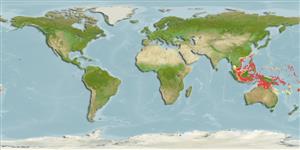>
Gobiiformes (Gobies) >
Gobiidae (Gobies) > Gobiinae
Etymology: Trimma: Greek, trimma, -atos = something crushed (Ref. 45335); xanthochrum: Name from the Greek ‘xanthos' meaning yellow or golden, and ‘chros’ for colour of the skin, or body surface, referring to the yellow colouration of the body and caudal fin..
More on author: Winterbottom.
Environment: milieu / climate zone / depth range / distribution range
Ecologia
marino demersale; distribuzione batimetrica 12 - 70 m (Ref. 87358). Tropical
Distribuzione
Stati | Aree FAO | Ecosystems | Presenze | Point map | Introduzioni | Faunafri
Western Pacific Ocean: Indonesia.
Size / Peso / Age
Maturity: Lm ? range ? - ? cm
Max length : 2.5 cm SL maschio/sesso non determinato; (Ref. 87358)
Short description
Morfologia | Morfometria
Spine dorsali (totale): 7; Raggi dorsali molli (totale): 7-8; Spine anali 1; Raggi anali molli: 8. This species is characterized by the following: a wide interorbital region (80-100% pupil diameter); the second dorsal spine usually reaching posteriorly to between the bases of the second to third dorsal fin rays; pectoral rays 15-16, usually with 7-8 branched rays; vertical rows of sensory papillae below eye of 2-3 papillae in rows 1-4 and 4-5 in row 5; caudal blotch which has a lower half about two-thirds the width of the upper half; usually an overall yellowish body with yellow at least proximally in the caudal fin (Ref. 87358).
Inhabits current-prone reefs in 12-70 m (Ref. 90102).
Life cycle and mating behavior
Maturità | Riproduzione | Deposizione | Uova | Fecundity | Larve
Winterbottom, R., 2011. Six new species of the genus Trimma (Percomorpha; Gobiidae) from the Raja Ampat Islands, Indonesia, with notes on cephalic sensory papillae nomenclature. aqua, Int. J. Ichthyol. 17(3):127-162. (Ref. 87358)
IUCN Red List Status (Ref. 130435)
Threat to humans
Harmless
Human uses
Informazioni ulteriori
Nomi ComuniSinonimiMetabolismoPredatoriEcotossicologiaRiproduzioneMaturitàDeposizioneSpawning aggregationFecundityUovaEgg development
Age/SizeAccrescimentoLength-weightLength-lengthLength-frequenciesMorfometriaMorfologiaLarveDinamica popolazioni larvaliReclutamentoAbbondanzaBRUVS
BibliografiaAcquacolturaProfilo di acquacolturaVarietàGeneticaElectrophoresesEreditarietàMalattieElaborazioneNutrientsMass conversion
CollaboratoriImmaginiStamps, Coins Misc.SuoniCiguateraVelocitàModalità di nuotoArea branchialeOtolithsCervelliVista
Strumenti
Special reports
Download XML
Fonti Internet
Estimates based on models
Preferred temperature (Ref.
123201): 26.7 - 28.9, mean 27.9 °C (based on 194 cells).
Phylogenetic diversity index (Ref.
82804): PD
50 = 0.5000 [Uniqueness, from 0.5 = low to 2.0 = high].
Bayesian length-weight: a=0.01023 (0.00477 - 0.02194), b=3.02 (2.84 - 3.20), in cm total length, based on LWR estimates for this (Sub)family-body shape (Ref.
93245).
Fishing Vulnerability (Ref.
59153): Low vulnerability (10 of 100).
